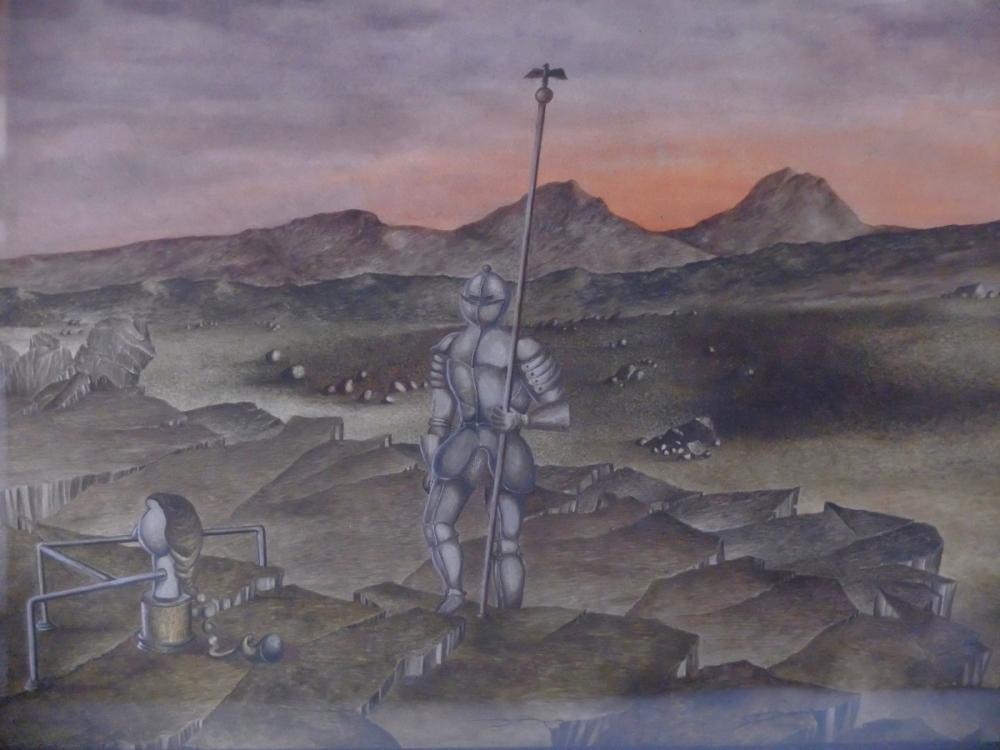
Steve Whitaker
Features Writer
12:00 AM 27th September 2025
arts
The Imp Of Surrealism: Anthony Earnshaw At Dean Clough
![Untitled (1946)]()
Untitled (1946)
It comes as no surprise to learn that the surrealist artist, Anthony Earnshaw, was a great admirer of Charlie Chaplin, or more particularly, the Chaplin of
Modern Times. Perhaps the affinity was closer to a sense of identification than admiration, for the film whose theme is ‘the triumph of the little isolated man, coping with a big wide world over which they have little control’ mirrors, in detail, the anomie which was a likely consequence of the artist’s own early experience. In interview, Earnshaw has described the condition of alienation that was a central plank of Chaplin’s polemic in
Modern Times, and will be familiar to anyone who has seen Albert Finney’s vitriolic portrayal of Arthur Seaton on the factory floor in the film version of
Saturday Night, Sunday Morning. The postwar production line grind channelled Earnshaw’s disaffection into an enthusiastic anarchism: his sense of the absurdity of capitalism was an ongoing grievance, provoking both vim and left-field wit in his surrealist pictorial excursions.
That he worked as a lathe-turner in a large engineering company in an early incarnation can only have precipitated Earnshaw’s distaste, and the satirical response is severally visible in the comprehensive exhibition of his work at Halifax’s Dean Clough. Not least in a finely detailed pen and ink drawing depicting a nonplussed ‘boss’s’ son who is dredging the slurry of his brain to establish the existential point of a drill bit whilst crushing a teddy. Earnshaw’s ‘cartoons’ are often accompanied by explanatory text boxes which work to brilliant, sardonic effect as observation, whilst pointing a bony finger at the contemporary sociopolitical landscape. ‘Teddy service’ marvellously undermines the inherent lunacy of capitalism in the detail of an engineering shop that includes a very serviceable illustration of a lathe, and pays lip-service to the artist’s own experience of machinery.
![In Memorium: Dorothy Rose Earnshaw nee Myers (1992)]()
In Memorium: Dorothy Rose Earnshaw nee Myers (1992)
Earnshaw’s tableaux reimagine Marx’s theory of alienation from the ground up and with wit and humour; definitions of surreality emerge at precisely the point at which the artist is allowed to interpret arid philosophical speculation by different means: Earnshaw’s art – of both dimensions – pokes satirical holes in the effluvia of absurdity, makes anomie into a condition of inevitable ridiculousness, and underwrites his instinctive rejection of modern capitalism with the cheerful disillusion of an early Skeptic. Nor does he limit his remit to the minutiae: skewering the deafening hubris of unrestricted macroeconomic growth in ‘Thirteen Shouting Americans’, Earnshaw’s brilliant drawing of a New York cityscape is punctuated with the word ‘Shout’ in speech bubbles emerging from random skyscrapers, as if to underline the faceless clamour for cash. Had
Mad Men appeared on our television screens before Earnshaw’s death in 2001, the artist might have felt truly vindicated in his simple dissection of excess, of making money for the sake of making money.
The ‘Wokker’, a kind of cartoon bird, is organic and sentient like a human, yet absorbed into the mechanical fabric of existence by the silt of ‘progress’, the wheels upon which he perambulates around the picture’s frames. Rendered in the form of a comic strip, Earnshaw’s dialectic between two Wokkers - one naive and unknowing, and one who has bought into the prevailing philosophy of materialism – is an object lesson in the perverse ascription of value to the process of production. Wokker’s worship of the machine, and Earnshaw’s mock-heroic reading of it, is made manifest in the accompanying speech bubbles. Addressing a huge gearwheel, Wokker’s awe bears the undiluted enthusiasm of Ozymandian eulogy: ‘Tell me, were you once some gleaming pinion engaged in the mighty engine of civilization?’
![Teddy Service]()
Teddy Service
The inverse hubris is typical of Earnshaw’s wit, whether defining the detritus of the modern, especially British, condition in the grid of an alphabet where the letters are shaped by contorted representations of its objects and denizens (‘Secret Alphabet No 8’), or describing a hanging from a lamppost in the gallows humour of an auteur who shares the despair of the deceased (‘About to Join Him’). That the artist’s hand is closing in on his own neck in this surreal excursion is an inference for negotiation, but we may be certain that the meticulous detailing of almost all of his pictures helps to foreground a bigger point, just as Earnshaw’s alphabet, reiterated here and elsewhere in different forms, yields a frank and, in places hilarious, evaluation of social mores and preoccupations.
The Dean Clough exhibition has been curated with one eye on evocation: thoughtfully balanced into sections of drawings, oil and sand creations and watercolours of different vintages, and provoking a range of emotion from incredulity to ribald laughter, from astonishment to pity, we are reminded of Earnshaw’s fluidity as an artist. When not transfiguring the purest form of anarchism in detachment by examining the consequences of late capitalism through a strange surreal lens, he elicits joy and sometimes pathos in skewed observation. A striking early watercolour of 1946 depicting a beautifully realised, fully armoured medieval knight undermines entirely any sense of propriety or chivalric purpose, when we find that he is alone in a near-lunar wasteland, all connotation wiped by the barren terrain (work untitled). And yet, the artful futility is balanced by a kind of humour that is hard to explain, as Earnshaw’s work so often is. Not least in the raddled foregrounding of an incarnation of his mother in a 1992 watercolour, whose appearance looks oddly submarine and lifeless, as though she had recently emerged dead from the pool behind her, in a surreal conclusion to the background tableau that describes the stages of her life, and, in a vignette as a child, her son and artist (‘In Memorium: Dorothy Rose Earnshaw, nee Myers’).
![Thirteen Shouting Americans
All images reproduced with the permission of Gail Earnshaw]()
Thirteen Shouting Americans
All images reproduced with the permission of Gail Earnshaw
Earnshaw’s versatility is self-evident; the forms he works in are diverse but somehow unitary. Fiercely original yet emanating a whiff of derivation that yields to audience inference, his images carry the marks of earlier pieces by abstract suggestion: the mother figure who stares directly at the viewer through watery eyes is Dali-esque, whilst the lone knight in the desiccated brown landscape is as lost to time as Holman-Hunt’s Pre-Raphaelite ‘Scapegoat’. Remarkable by any estimation, Anthony Earnshaw’s art is well served by his own philosophical intransigence and it is a testimony to Dean Clough’s perspicacity that its now celebrated art space should feature an exhibition that can accommodate the extraordinary breadth of his work.
Anthony Earnshaw: The Imp of Surrealism runs at the Crossley Gallery, Dean Clough, Halifax until 12th October
Entry Free
More information here. 




